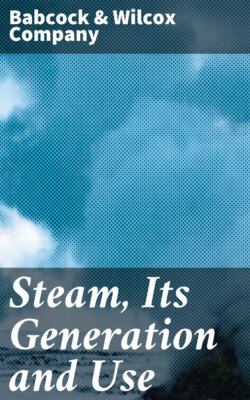Читать книгу Steam, Its Generation and Use - Babcock Wilcox Company - Страница 19
На сайте Литреса книга снята с продажи.
TABLE 4
ОглавлениеSPECIFIC HEATS OF VARIOUS SUBSTANCES
+——————————————————————————————————+
| SOLIDS |
+———————————————+————————+—————————+
| | Temperature[2]| |
| | Degrees | Specific |
| | Fahrenheit | Heat |
+———————————————+————————+—————————+
| Copper | 59–460 | .0951 |
| Gold | 32–212 | .0316 |
| Wrought Iron | 59–212 | .1152 |
| Cast Iron | 68–212 | .1189 |
| Steel (soft) | 68–208 | .1175 |
| Steel (hard) | 68–208 | .1165 |
| Zinc | 32–212 | .0935 |
| Brass (yellow) | 32 | .0883 |
| Glass (normal ther. 16^{III}) | 66–212 | .1988 |
| Lead | 59 | .0299 |
| Platinum | 32–212 | .0323 |
| Silver | 32–212 | .0559 |
| Tin | −105–64 | .0518 |
| Ice | | .5040 |
| Sulphur (newly fused) | | .2025 |
+———————————————+————————+—————————+
| LIQUIDS |
+———————————————+————————+—————————+
| | Temperature[2]| |
| | Degrees | Specific |
| | Fahrenheit | Heat |
+———————————————+————————+—————————+
| Water[3] | 59 | 1.0000 |
| Alcohol | 32 | .5475 |
| | 176 | .7694 |
| Mercury | 32 | .03346 |
| Benzol | 50 | .4066 |
| | 122 | .4502 |
| Glycerine | 59–102 | .576 |
| Lead (Melted) | to 360 | .0410 |
| Sulphur (melted) | 246–297 | .2350 |
| Tin (melted) | | .0637 |
| Sea Water (sp. gr. 1.0043) | 64 | .980 |
| Sea Water (sp. gr. 1.0463) | 64 | .903 |
| Oil of Turpentine | 32 | .411 |
| Petroleum | 64–210 | .498 |
| Sulphuric Acid | 68–133 | .3363 |
+———————————————+————————+—————————+
| GASES |
+—————————————+———————+———————+—————+
| | | Specific | Specific |
| | Temperature[2]| Heat at | Heat at |
| | Degrees | Constant | Constant |
| | Fahrenheit | Pressure | Volume |
+—————————————+———————+———————+—————+
| Air | 32–392 | .2375 | .1693 |
| Oxygen | 44–405 | .2175 | .1553 |
| Nitrogen | 32–392 | .2438 | .1729 |
| Hydrogen | 54–388 | 3.4090 | 2.4141 |
| Superheated Steam | | See table 25 | |
| Carbon Monoxide | 41–208 | .2425 | .1728 |
| Carbon Dioxide | 52–417 | .2169 | .1535 |
| Methane | 64–406 | .5929 | .4505 |
| Blast Fur. Gas (approx.) | … | .2277 | … |
| Flue gas (approx.) | … | .2400 | … |
+—————————————+———————+———————+—————+
Latent heat is not lost, but reappears whenever the substances pass through a reverse cycle, from a gaseous to a liquid, or from a liquid to a solid state. It may, therefore, be defined as stated, as the heat which apparently disappears, or is lost to thermometric measurement, when the molecular constitution of a body is being changed. Latent heat is expended in performing the work of overcoming the molecular cohesion of the particles of the substance and in overcoming the resistance of external pressure to change of volume of the heated body. Latent heat of evaporation, therefore, may be said to consist of internal and external heat, the former being utilized in overcoming the molecular resistance of the water in changing to steam, while the latter is expended in overcoming any resistance to the increase of its volume during formation. In evaporating a pound of water at 212 degrees to steam at 212 degrees, 897.6 B. t. u. are expended as internal latent heat and 72.8 B. t. u. as external latent heat. For a more detailed description of the changes brought about in water by sensible and latent heat, the reader is again referred to the chapter on "The Theory of Steam Making".
Ebullition—The temperature of ebullition of any liquid, or its boiling point, may be defined as the temperature which exists where the addition of heat to the liquid no longer increases its temperature, the heat added being absorbed or utilized in converting the liquid into vapor. This temperature is dependent upon the pressure under which the liquid is evaporated, being higher as the pressure is greater.
